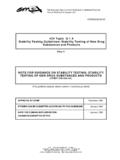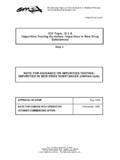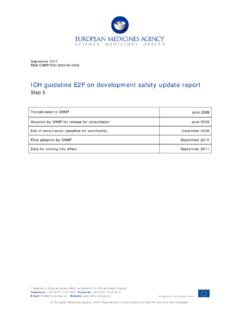Transcription of European Medicines Agency
1 European Medicines Agency September 1999. CPMP/ICH/365/96. ICH Topic Q 6 B. Specifications: Test Procedures and Acceptance Criteria for Biotechnological/Biological Products Step 5. NOTE FOR GUIDANCE ON. SPECIFICATIONS: TEST PROCEDURES AND ACCEPTANCE CRITERIA FOR. BIOTECHNOLOGICAL/BIOLOGICAL PRODUCTS. (CPMP/ICH/365/96). TRANSMISSION TO CPMP February 1998. RELEASE FOR CONSULTATION February 1998. DEADLINE FOR COMMENTS July 1998. FINAL APPROVAL BY CPMP March 1999. DATE FOR COMING INTO OPERATION September 1999. 7 Westferry Circus, Canary Wharf, London, E14 4HB, UK. Tel. (44-20) 74 18 85 75 Fax (44-20) 75 23 70 40.
2 E-mail: EMEA 2006 Reproduction and/or distribution of this document is authorised for non commercial purposes only provided the EMEA is acknowledged SPECIFICATIONS: TEST PROCEDURES AND ACCEPTANCE CRITERIA FOR. BIOTECHNOLOGICAL/BIOLOGICAL PRODUCTS. ICH Harmonised Tripartite Guideline Table of Contents Page 1. 2. Objective .. 3. Background .. 3. Scope 3. 2. PRINCIPLES FOR CONSIDERATION IN SETTING SPECIFICATIONS .. 4. Characterisation .. 4. Physicochemical properties .. 4. Biological 5. Immunochemical properties .. 5. Purity, impurities and contaminants .. 6. Quantity .. 7. Analytical Considerations .. 7. Reference standards and reference 7.
3 Validation of analytical procedures .. 7. Process 8. Process-related 8. In-process acceptance criteria and action limits .. 8. Raw materials and excipient specifications .. 8. Pharmacopoeial Specifications .. 9. Release Limits vs. Shelf-life 9. Statistical Concepts .. 9. 3. JUSTIFICATION OF THE 9. 4. SPECIFICATIONS .. 10. Drug Substance Specification .. 10. Appearance and 10. 10. Purity and 11. Potency .. 11. Quantity .. 11. Drug Product Specification .. 11. Appearance and 11. 12. Purity and 12. Potency .. 12. Quantity .. 12. General 12. Additional testing for unique dosage 12. 5. GLOSSARY 13. 6. APPENDICES 15.
4 Appendix for Physiochemical 15. Structural characterisation and confirmation .. 15. Physicochemical properties .. 16. Appendix for 16. Process-related impurities and 17. Product-related impurities including degradation products .. 17. 1. INTRODUCTION. EMEA 2006 2. Objective This guidance document provides general principles on the setting and justification, to the extent possible, of a uniform set of international specifications for biotechnological and biological products to support new marketing applications. Background A specification is defined as a list of tests, references to analytical procedures, and appropriate acceptance criteria which are numerical limits, ranges, or other criteria for the tests described.
5 It establishes the set of criteria to which a drug substance, drug product or materials at other stages of its manufacture should conform to be considered acceptable for its intended use. Conformance to specification means that the drug substance and drug product, when tested according to the listed analytical procedures, will meet the acceptance criteria. Specifications are critical quality standards that are proposed and justified by the manufacturer and approved by regulatory authorities as conditions of approval. Specifications are one part of a total control strategy designed to ensure product quality and consistency.
6 Other parts of this strategy include thorough product characterisation during development, upon which many of the specifications are based, adherence to Good Manufacturing Practices, a validated manufacturing process, raw materials testing, in-process testing, stability testing, etc. Specifications are chosen to confirm the quality of the drug substance and drug product rather than to establish full characterisation and should focus on those molecular and biological characteristics found to be useful in ensuring the safety and efficacy of the product. Scope The principles adopted and explained in this document apply to proteins and polypeptides, their derivatives, and products of which they are components ( , conjugates).
7 These proteins and polypeptides are produced from recombinant or non-recombinant cell-culture expression systems and can be highly purified and characterised using an appropriate set of analytical procedures. The principles outlined in this document may also apply to other product types such as proteins and polypeptides isolated from tissues and body fluids. To determine applicability, manufacturers should consult with the appropriate regulatory authorities. This document does not cover antibiotics, synthetic peptides and polypeptides, heparins, vitamins, cell metabolites, DNA products, allergenic extracts, conventional vaccines, cells, whole blood, and cellular blood components.
8 A separate ICH Guideline, Specifications:Test Procedures and Acceptance Criteria for New Drugs Substances and New Drug Products: Chemical Substances addresses specifications, and other criteria for chemical substances. This document does not recommend specific test procedures or specific acceptance criteria nor does it apply to the regulation of preclinical and/or clinical research material. EMEA 2006 3. 2. PRINCIPLES FOR CONSIDERATION IN SETTING SPECIFICATIONS. Characterisation Characterisation of a biotechnological or biological product (which includes the determination of physicochemical properties, biological activity, immunochemical properties, purity and impurities) by appropriate techniques is necessary to allow relevant specifications to be established.
9 Acceptance criteria should be established and justified based on data obtained from lots used in preclinical and/or clinical studies, data from lots used for demonstration of manufacturing consistency and data from stability studies, and relevant development data. Extensive characterisation is performed in the development phase and, where necessary, following significant process changes. At the time of submission, the product should have been compared with an appropriate reference standard, if available. When feasible and relevant, it should be compared with its natural counterpart. Also, at the time of submission, the manufacturer should have established appropriately characterised in-house reference materials, which will serve for biological and physicochemical testing of production lots.
10 New analytical technology and modifications to existing technology are continually being developed and should be utilised when appropriate. Physicochemical properties A physicochemical characterisation program will generally include a determination of the composition, physical properties, and primary structure of the desired product. In some cases, information regarding higher-order structure of the desired product (the fidelity of which is generally inferred by its biological activity) may be obtained by appropriate physicochemical methodologies. An inherent degree of structural heterogeneity occurs in proteins due to the biosynthetic processes used by living organisms to produce them; therefore, the desired product can be a mixture of anticipated post-translationally modified forms ( , glycoforms).













